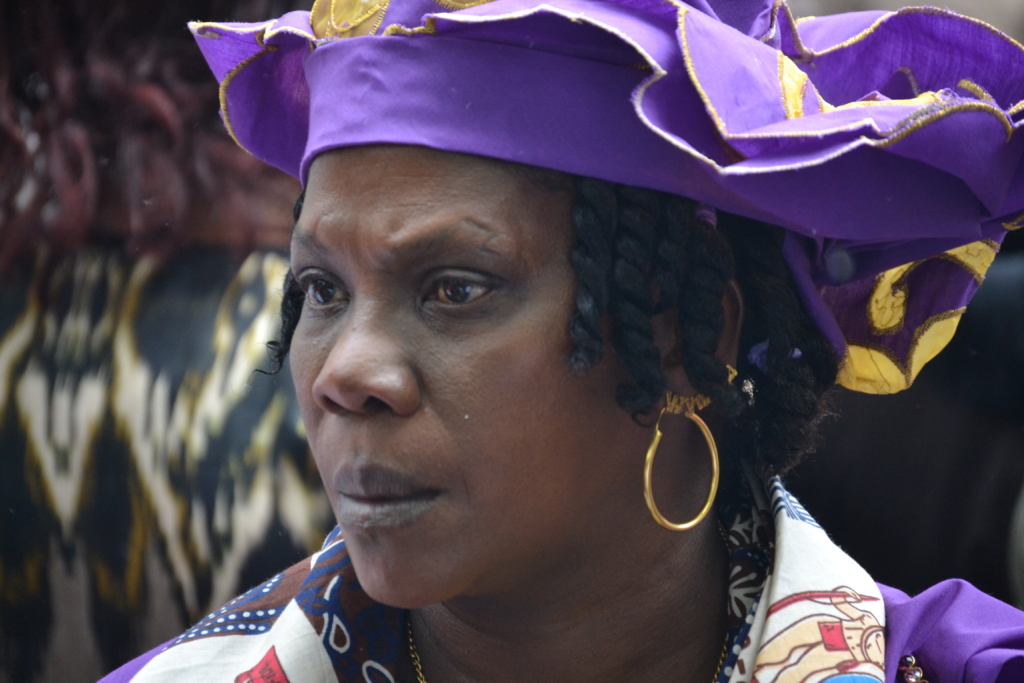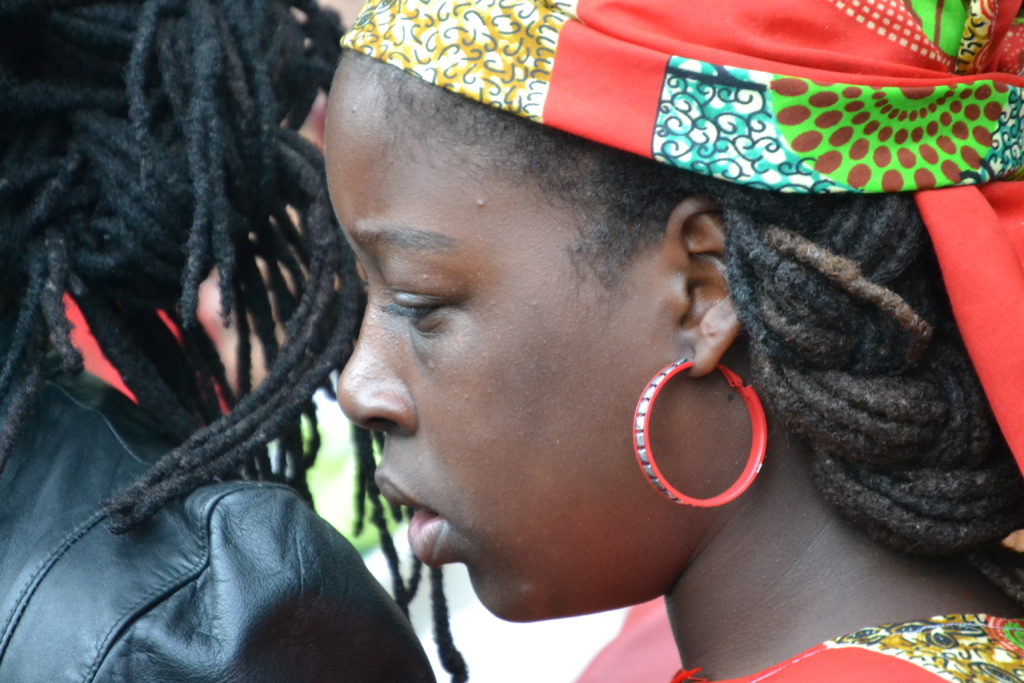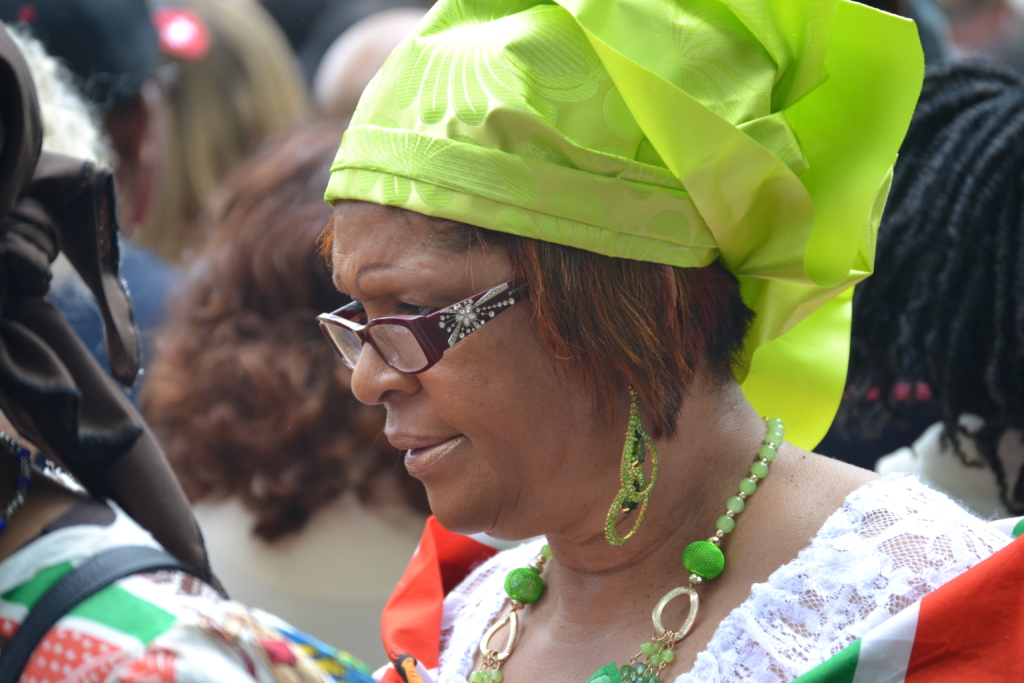De semiotiek van de Koto-missi
door Ken Mangroelal
Kleding maakt de man en waarom ook niet de vrouw. Dat geldt zeker voor mijn middelbareschoolperiode beginjaren zestig in Amsterdam. Wij leerlingen moesten altijd pico bello ten tonele verschijnen. En met enige nostalgie denk ik terug aan mijn colbertjasjes met bijpassende vestjes daaronder. Roken was ook strikt verboden, zelfs in de straat van de school dicht bij het Concertgebouw.

Denise Jannah in Koto & angisa, Keti koti 2013. Alle foto’s © Michiel van Kempen
Met de meiden in minirok en jongens met lang haar deed de culturele revolutie haar intrede. De meiden werden naar huis gestuurd om zich om te kleden en de jongens moesten naar de kapper. Het was de tijd van het autoritaire gezag dat spoedig het veld moest ruimen voor individuele vrijheid en de stropdas als symbool van ancième regime de das werd omgedaan en door prins Claus haar definitieve nekslag werd gegeven. De prominenten van Silicon Valley celebreren deze overwinning op het oude gezag onwetend als ze zonder stropdas op hun presentaties verschijnen.
Maar ik wil het over de Koto-missi hebben, over haar klederdracht en daarmee verweven doctrine van tekens. Ferdinand de Saussure (1857-1913 ) inaugureerde in zijn baanbrekend werk Cours de linguistique générale (1916) een wetenschap, de semiologie die het teken (semeion, Grieks) in het hart van het sociale leven zou bestuderen (Cours de linguistique générale, p. 33: On peut donc concevoir une science qui étudie la vie des signes au sein de la vie sociale).
De Koto-missi van vervlogen dagen stond met haar tekensysteem midden in het sociale leven. Middels haar hoofddoek (angisa) als drager van haar semiotiek communiceerde zij met haar omgeving. En hoe?
Te beginnen met de naamgeving van haar hoofddoek. Die droeg meestal de naam van een spreekwoord naar Afrikaaans gebruik. Via het spreekwoord reageerde zij op een sociale gebeurtenis waar ze commentaar op wenste te leveren. En hoe ging dat in zijn werk?
Laten wij enige voorbeelden geven. De voorbeelden ontleen ik aan het werk van Herskovits, Suriname folk-lore (1936) dat op www.dbnl.org te vinden is. Ik citeer hem integraal gezien zijn voorbeelden de samenhang van teken, referent en betekenis zo duidelijk inzichtelijk maken.

Angisa (hoofddoek). De foto’s van deze angisa’s zijn NIEt de angisa’s die in de tekst worden beschreven!!
Voorbeelden:
1
It is said that some years ago, a man of official rank in the church was recalled from the colony because of gossip which connected his name with that of a woman in the city.
The town Negroes, who enjoy comment on the vagaries of the White people of the colony, took occasion, under the protection of the double entendre which is part of the African character of these proverb-names, to make popular a kerchief with this saying: ‘All Bush animals eat (steal) cassava, but only the rabbit has the name for doing it.’ (Ala busi meti nyam kasaba, ma konkoni tyari nem.)
2
‘When the cow has eaten, she must give the horse the right to graze.’ (Te Kauna nyam, a mu gi ‘asi pasi.) This saying was related to an occurrence which took place among the Negroes themselves. A woman who had lived with a man for many years, found herself deserted in favor of a young girl who had taken her man’s fancy. This woman was ill, and the feeling, while one of commiseration with her, was not one of sympathy, since it was felt that, having had her day, she should step aside.

3
‘Anansi is cunning, yet today the Tiger rides him.’ ( Anansi koni, ma tide tigri rai na hem baka.) This saying comments on the experience of a Negro editor who had resorted to free criticism in his paper for many years, and on one occasion was disciplined for some especially daring comment.
4
‘Anansi climbed the thorny palm-tree,’ describes the fate of a Negro who escaped punishment for the sharp practices he carried on over a long period of years, until one day he was apprehended and imprisoned.

Ook werd soms een woord of frase gebruikt als benaming van een hoofddoek. En dat vaak met het doel om spot te drijven.
One was named ‘Porcupine’, and the other, ‘Bushmaster’. Both of these touched upon the difficulties which arose between two women who had been living together in the institutionalised form of sexual inversion found among the Paramaribo Negroes. After thirteen years of this relationship, one of them formed an attachment for a young boy, and there were quarrels and threats of black magic. The choice of the kerchiefs involved partisanship as well as amusement at the occurrence.
De wijze van vouwen van de hoofddoek opende nieuwe mogelijkheden en wel het ontwerp van tekens om de gemoedsstemmingen van de draagster tot uitdrukking te brengen.

1
Thus, one type of tying is called trɔbi, ‘trouble’. The kerchief, folded into a triangle, is arranged carefully in front, but the ends hang loosely in back. This at once characterises a bad tempered woman, who is to be avoided if there is to be no quarrelling; and when women skilled in magic tie their kerchiefs in this way, they are approached with the greatest tact. When we saw quarrelling women in the streets, it was remarkable in how many instances their kerchiefs were tied with flapping ends. The implication of the flapping ends is that the wearer is indifferent to what people do or say, ‘all the evil wishes are spoken to the wind, and all evil the wind will blow away.’
2
Another style of tying is given the designation of ‘wakti mi na tap’-uku, – wait for me on the corner.’ A kerchief so tied has a straight line in back, and a slight opening to one side, and is considered a signal to men.

3
Another of this general category of loosely-tied kerchiefs is called motyo-ɛde, ‘prostitute’, and is the kerchief of a loose woman. It is tied so that
there is a short straight line in back, which symbolizes a road, and a large opening with loose ends to indicate that the men are to follow her, and ‘be at home’. Still another is made to resemble a fan in back. Its name is ‘Yu ką wai̯ yu wɩnti lɔntu foto, ma mi no sa drai̯ baka, –
You can fan your breath around town, but I will not return.’ It is worn to express a woman’s sentiments toward a man with whom she has quarrelled and whom she has left, and bodes hini no good. One kerchief has a small plaited end to represent a fan, and carries the name, ‘Yu lɔbi na mąn, a no lɔbi yu, – You love the man, but he doesnot love you (as yet)’, and this style of head-dress signifies that the wearer is fanning some man’s emotions, so that he might notice her.
4
A way of tying kerchiefs which, it was said, is very old, is called broko hɛde, ‘broken head’. A kerchief tied in this manner used to be worn
by young girls as a sign that they had already had sex relationship, but today this style is not much worn. The complement to this is the method of tying known as yungu-mei̯ djɛ hɛde, ‘young girl’s head’, where all loose ends are tucked in, and a girl wearing it is marked as a virgin, – to be specific, it was said that ‘this kerchief is worn before a girl has a man, to show that she is ready for one.’
One style of kerchief-tying is done in a fashion called frɩnskap, ‘friendship’ (really ‘love’). At the back this has two open corners but no flapping ends; one of the open places represents the woman, the other the man, and the knot made in the center of the design stands for the woman’s heart, open to him. When worn, this style signifies that the wearer’s love for her man is reciprocated.
Other styles are brasa mi trąŋga, ‘hug me tight’; yu sa si mi baka.
Indrukwekkend die Koto-missi’s. Lang leve hun inventiviteit.

